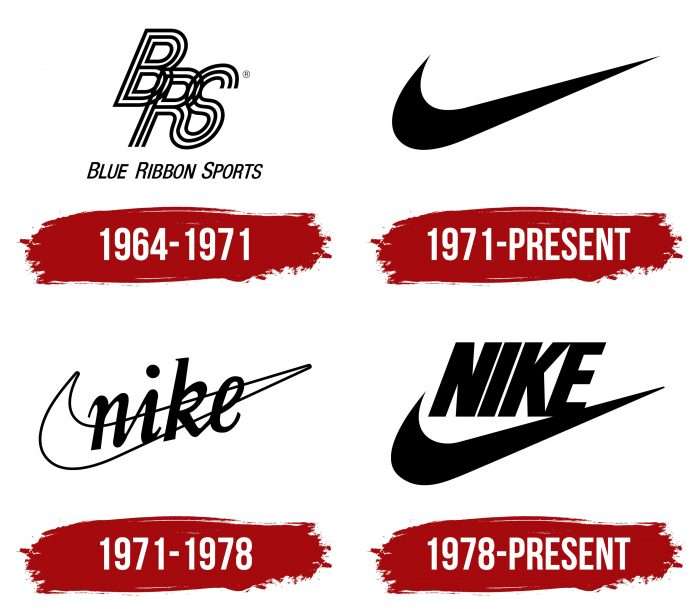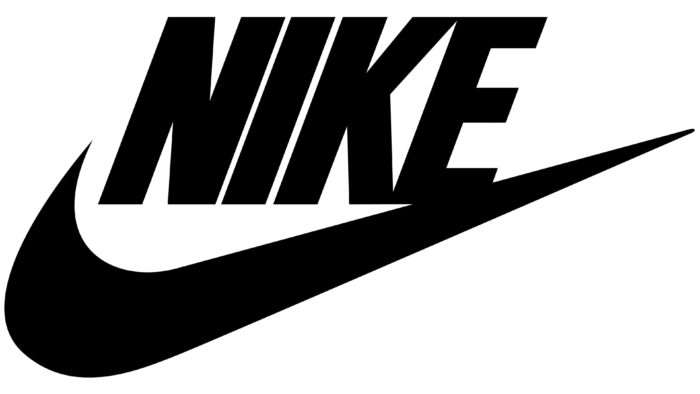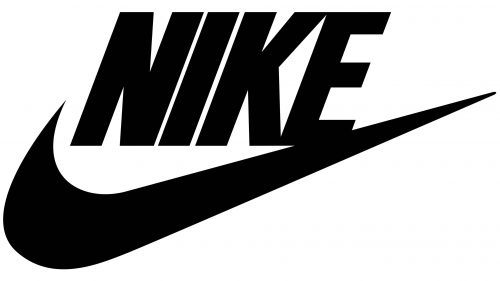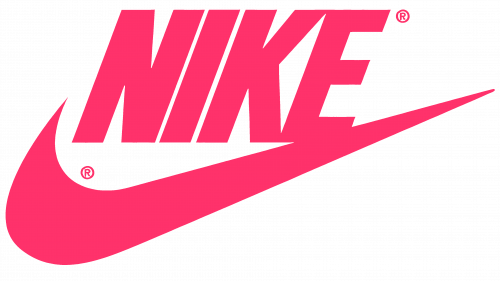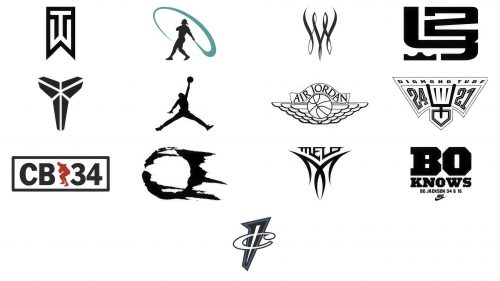The universally recognizable Nike logo emerged thanks to a fortunate coincidence. The sign’s conciseness and elegance have become a distinctive symbol showcasing the features of the offered products. Its aesthetics and graphic authenticity reflect the important characteristics of sports goods.
Nike: Brand overview
From its humble beginnings as Blue Ribbon Sports in 1964, selling Japanese Onitsuka Tiger sneakers to becoming the titan of the sports industry known as Nike, this brand’s journey is a tale of vision, innovation, and relentless pursuit of excellence. Phil Knight and Bill Bowerman, the founders, shifted gears in 1971, transitioning from a distributor to a powerhouse brand that now dominates over 60% of the sports footwear market worldwide. This pivotal year marked the introduction of the Nike name, inspired by the Greek goddess of victory, and saw the creation of the iconic Swoosh logo. This symbol would become synonymous with athletic achievement and style.
By 1972, Nike had made its Olympic debut in Munich, a testament to its growing influence in the sports world. The 1980s were particularly transformative, with the company going public and beginning its global expansion. The partnership with Michael Jordan in 1984 was revolutionary, launching the Air Jordan line, which remains a pinnacle of sneaker culture.
The introduction of the “Just Do It” slogan in 1987 encapsulated Nike’s ethos, inspiring a generation to push beyond limits. The 1990s and 2000s saw Nike expand its product line, embrace technological innovations, and forge partnerships with sports stars across the globe. This era solidified Nike’s market dominance and commitment to sports development.
Entering the 2010s, Nike focused on diversification, acquiring brands like Converse and Hurley and emphasizing sustainability, reflecting its adaptability and forward-thinking approach. Today, with annual revenues exceeding $40 billion, Nike is the largest sports goods manufacturer globally, an icon of style, and a symbol of sporting success. Nike’s history teaches how branding, innovation, and clear positioning can build an empire that leads the market and changes the cultural world of sports.
Meaning and History
Runner Phil Knight became one of the founders of a powerful company producing sports equipment. It all started with sports shoes, which Phil began to import from Japan, as the American market was oversaturated with expensive brands not always affordable for ordinary citizens.
Carolyn Davidson’s 1971 creation of the Nike Swoosh logo is a testament to the unforeseen paths that lead to iconic outcomes. This emblem, now synonymous with one of the most recognizable brands globally, originated from a serendipitous encounter and a modest design project. Phil Knight, Nike’s co-founder, was not immediately taken with the Swoosh when it was first presented to him. His initial reservation about the design underscores the unpredictable nature of creative endeavors and how perceptions of value can evolve.
Davidson’s opportunity to design the logo came about almost by chance. As a graphic design student at Portland State University, she needed extra funds, a dilemma Knight, a faculty member teaching accounting, overheard. Offering her a job to create signage for his nascent company at $2 per hour, Knight unknowingly set the stage for the creation of a global symbol.
The design brief was simple yet challenging: to conceive a logo that captured the essence of motion and stood apart from competitors, notably Adidas, known for its straightforward three-stripe design. A singular, fluid curve, Davidson’s solution embodied motion and differentiation in its most elegant form. Initially described as the “strip,” this design evolved into the “Swoosh,” a name that suggests the sound of speed and movement, aptly reflecting the innovation and dynamism of Nike’s products.
The Swoosh, completed in less than 20 hours of work, transcended its humble beginnings to become a symbol of athletic excellence and cultural significance. This journey from an underappreciated design to an iconic logo illustrates the unpredictable nature of branding and the impact of visionary design. Carolyn Davidson’s contribution to Nike’s brand identity is a remarkable narrative of creativity, chance encounters, and the enduring power of a simple yet profound visual symbol.
What is Nike?
Nike is an American international company specializing in the development and sale of sportswear, footwear, and branded equipment. The production is carried out by contractors from the Asian region. The brand has existed since 1964 and owns a network of stores scattered around the world: there are more than 1150 of them. The headquarters of the company is located near the city of Beaverton, Oregon.
The Nike Logo Evolution
The Swoosh stands as a towering symbol in the brand logos landscape, boasting a history spanning over five decades. This emblem, instantly recognizable and deeply embedded in the cultural fabric, evokes the legacy of Nike’s innovative products with just a glance. However, the iconic Swoosh is not the lone emblem under Nike’s expansive banner. The company boasts diverse symbols, each with its own story, contributing to a vast catalog with more than a dozen distinctive logos.
Within Nike’s emblematic library are logos crafted for specific purposes—from sneaker models and celebrated athletes to major events and collaborations with partner organizations. Among these, the Jumpman logo stands out, capturing the essence of Michael Jordan’s legendary prowess and becoming synonymous with basketball excellence. Additionally, the powerful slogan “Just Do It” transcends its initial advertising purpose, inspiring athletes and non-athletes with a message of perseverance and determination.
The Nike Logo History
The Nike logo, synonymous today with the brand’s cutting-edge sneakers, did not debut on footwear designed for the track or the basketball court. Instead, this iconic emblem first graced soccer boots in 1971, beginning its journey across the sports world. The logo started to adorn other sports equipment and apparel only after this initial appearance, eventually becoming a staple on Nike’s renowned sneakers.
In the early years of its existence, the Nike logo was presented in a vivid red and white color scheme, a choice that is less remembered today. The founders of Nike selected red for its deep symbolic meanings—energy, power, speed, and passion—all attributes they aspired to embed within the core identity of the Nike brand and its emblem. On the other hand, White was chosen for its association with transparency and loyalty, further emphasizing the brand’s values.
Over time, in pursuit of a more versatile and universally recognizable identity, Nike transitioned its logo to the stark simplicity of black and white. This shift solidified the emblem’s iconic status and enhanced its adaptability, allowing it to integrate seamlessly into various designs and products. The evolution of the logo’s color palette reflects Nike’s strategic approach to brand identity, ensuring that its badge remains a powerful symbol of excellence in sports and beyond.
1964 – 1970
Phil Knight founded the Blue Ribbon Sports company to supply footwear from Japan. Athletes liked the shoes, and they sold well. Then, the idea arose to expand production and open their manufacturing base. At that time, the company’s logo was a simple combination of the letters “BRC” in the company’s name.
1971 – today
The BRC acronym, used as a graphic sign from 1964 to 1971, went unnoticed. The brand’s most famous symbol became “Swoosh” – a rounded flag with pointed ends. Carolyn Davidson, a graphic design student needing money, invented this logo. Knight hired her to design a logo for Blue Ribbon Sports. However, he did not like the result and paid only $35 for the drawing (at $2 per hour).
Carolyn was also not thrilled with her work: the student simply put ticks, upset about failing to create something unique. However, the Swoosh became a recognizable feature of the brand, and its creator, ten years later, received a worthy reward: an envelope with shares amounting to $643,035.
1971 – 1978
Throughout Nike’s history, this logo has changed several times. In 1971, the icon was white – it stood out only thanks to a black outline. The word “Nike,” typed in italics, was at the top.
1978 – today
In 1978, designers moved the word upward, emphasized the letters with uppercase, and used the sans-serif font Futura Bold. In 1985, experimenters updated the palette, placing the white logo inside a red square.
The final version of the brand name was presented in 1995. Developers took the minimalist route, removing the inscription and geometric shape. Only the Swoosh remained. It first appeared on football boots in 1972 and has hardly changed since.
The Inspiration Behind the Logo
When Carolyn Davidson embarked on the challenge of designing the iconic logo for Nike, she drew inspiration from Greek mythology and kept a keen eye on the competition. Understanding and differentiating from competitors is critical in professional visual identity design. Nike’s primary rival at the time, the globally renowned Adidas, was particularly influential with its distinctive logo featuring three lines at a precise angle. This design element symbolized energy and movement, qualities that Davidson sought to encapsulate in her creation for Nike.
Davidson appreciated the dynamic energy conveyed by the angle in Adidas’s logo but decided to forge a distinct path. Rather than adopting multiple lines, she envisioned a single, solid form. This innovative approach resulted in a logo that retained the essence of movement and vigor but introduced a sleeker, more fluid geometry. The transformation of three separate lines into one thick, continuous shape set the Nike logo apart from Adidas and imbued it with a unique sense of motion and simplicity.
This thoughtful consideration in the design process highlights Davidson’s skillful navigation of competitive influences. By reimagining the concept of angles and lines, she crafted a logo that stood out from Nike’s main competitor and became a globally recognized symbol of athleticism and performance. Through Davidson’s creative process, the Nike Swoosh emerged as a testament to the power of innovative design in establishing a brand’s visual identity.
How much did the emblem cost?
The story behind the creation of the Nike Swoosh and the compensation its designer, Carolyn Davidson, received is indeed one of the most fascinating anecdotes in the world of branding. Initially, Davidson was compensated with a mere $35 for her design work, which, when adjusted for inflation to 2017 dollars, amounts to approximately $215. This modest sum reflects the circumstances of the time: Davidson was not yet a professional designer, and Phil Knight, co-founder of Nike, was only beginning to build what would become one of the most successful and recognizable brands globally.
Davidson was a graphic design student at Portland State University when Knight approached her, then an accounting professor with a fledgling sneaker company. The task was to create a logo that symbolized movement and speed, and Davidson’s design, the Swoosh, perfectly captured that essence. At the time, neither could have predicted this symbol’s immense impact on the global market and culture.
However, the story did not end with that $35 payment. In recognition of Swoosh’s invaluable contribution to Nike’s brand identity and success, Knight made a grand gesture of appreciation in 1983. During a company lunch, Davidson was presented with a diamond ring shaped like the Swoosh logo, symbolizing the enduring value of her contribution. Additionally, she received an envelope containing Nike stock. Initially valued at $150, these shares had appreciated to a staggering $643,000 by the time of public disclosure. This gesture was a significant acknowledgment of Davidson’s role in Nike’s history and a testament to the company’s growth. While she may not consider herself a millionaire, her acknowledgment from Nike ensured she lived comfortably, with the knowledge that her design continued to be a globally recognized symbol of excellence and innovation in sports.
Just Do It!
Amid the 1980s, a fitness craze swept across the globe, significantly expanding the athletic wear and equipment market. Nike, a brand traditionally focused on equipping athletes, recognized a pivotal opportunity for growth. It became apparent that to tap into this burgeoning market of everyday fitness enthusiasts, a shift in strategy—in product offerings and marketing- was essential. Nike’s response was a powerful promotional campaign that would redefine its brand identity and broaden its appeal.
In 1988, Nike sought the expertise of the advertising agency Wieden+Kennedy (W&K) to craft a campaign that would resonate with a wider audience. Dan Wieden, the agency’s co-founder, introduced the slogan “Just Do It,” drawing unlikely inspiration from the final words of Gary Gilmore—”Let’s do it.” Gilmore, who was executed in 1977 for murder, might seem an unconventional muse for a motivational campaign. Yet, Wieden’s adaptation transformed the phrase into a universal call to action, challenging individuals to overcome procrastination and doubt.
A year after the slogan’s introduction, designer Ron Dumas unveiled its graphic embodiment, utilizing the bold lines of the Futura Bold Condensed font. This typographic choice lent the slogan an air of immediacy and strength, further embedding it into the cultural zeitgeist. Over the years, the “Just Do It” logotype has ascended to become Nike’s second most iconic emblem, synonymous not with its grim origins but with the brand’s commitment to speed, motion, and the empowerment of its customers to pursue their goals. Today, the “Just Do It” slogan is a testament to Nike’s successful pivot from a brand for athletes to a brand for everyone.
Symbol Modifications
Since its inception in 1971, the Nike Swoosh has undergone subtle yet significant transformations, evolving with the brand’s expanding identity and market presence. While the fundamental shape of the Swoosh has remained largely consistent, these changes reflect shifts in branding strategy and aesthetic preferences over the years.
In the logo’s early days, the Nike name was integrated into the emblem, featuring a typeface that mimicked handwriting. This design placed the Swoosh in the background, creating a dynamic interplay between the symbol and the brand name. The emblem was characterized by its use of negative space, with the letters and the Swoosh presented in a striking dark shade of blue against a darker background, embodying a bold and distinctive visual identity.
A pivotal change occurred in 1978 when the placement and presentation of the Nike name were reimagined. The brand name was moved above the Swoosh, and a new typeface was introduced, displaying the letters in uppercase. This modification enhanced the logo’s legibility and reinforced the brand’s growing authority in the sports apparel industry.
By 1985, the logo underwent another subtle revision in its color scheme. The original blue was replaced with a deep shade of red, injecting a new energy and vibrancy into the brand’s visual representation. This color shift mirrored Nike’s expanding influence and the boldness of its products and marketing strategies.
In recent years, Nike has preferred to use the Swoosh independently, primarily in a stark black-and-white color scheme. This minimalist approach underscores the logo’s iconic status and versatility. Additionally, it’s not uncommon to see the Swoosh paired with the “Just Do It” slogan, a combination first introduced in 1988. This pairing has become emblematic of Nike’s motivational messaging and commitment to inspiring athletic excellence and determination.
Icon
The Nike Swoosh, an emblem now synonymous with the brand’s global presence, encapsulates the essence of speed and motion through its very name, miming the sound of fast-moving air. This iconic mark, designed to represent the wing of the Greek goddess of victory, Nike, has evolved into a universal symbol of continuous and unbroken movement. The inclusion of Nike’s empowering slogan, “Just Do It,” further amplifies Swoosh’s message, urging athletes toward action, new achievements, and heights of accomplishment. This combination of visual and verbal branding is a potent motivator, encapsulating Nike’s mission to inspire and innovate in sports and beyond.
Nike’s Swoosh stands out in the corporate world for its distinctive design and unique name that is instantly recognizable and doesn’t bring anything to mind other than the brand it represents. This level of brand identity is rare and speaks to the profound impact the Swoosh has had on culture and commerce alike.
The ubiquity of the Swoosh across Nike’s product lines—from sneakers to apparel and everything in between—underscores its importance as a cornerstone of the brand’s visual identity. Its application in a monochrome palette enhances its versatility and timelessness. The stark contrast of a solid black Swoosh against a white background, or vice versa, exemplifies contemporary, minimalist design principles, making the logo as effective on the web as it is in physical form. The design’s simplicity and the adaptability of its color scheme allow for seamless integration across various mediums, maintaining the brand’s cohesive and progressive image.
Nike SB Logo
The Nike Skateboarding brand, often abbreviated as Nike SB, represents Nike’s dedicated line of skateboarding shoes, apparel, and equipment. Launched in March 2002, it targets the skateboarding community with specialized products designed to meet the sport’s unique demands. The Nike SB logo maintains the iconic Swoosh emblem, synonymous with Nike’s overarching brand identity, signifying movement, speed, and precision. However, the logo incorporates the ” SB ” letters positioned directly below the Swoosh to distinguish this line.
This subtle yet significant addition serves multiple purposes. Firstly, it identifies the products as part of Nike’s skateboarding range, catering specifically to the skateboarding community. Secondly, it retains the brand’s strong identity and heritage by keeping the Swoosh as the dominant element, ensuring that the Nike SB line is immediately recognizable as part of the larger Nike family. This strategic branding decision allows Nike to extend its reach into the skateboarding niche while maintaining its overarching image of athletic excellence and innovation.
Nike AIR Logo
The Nike AIR logo is a distinctive variation of the brand’s standard emblem, specifically designed to represent Nike’s innovative Air technology. This technology, which incorporates pressurized air within the soles of the shoes to provide cushioning and support, has been a cornerstone of Nike’s product innovation since its introduction. The logo maintains the iconic Swoosh, symbolizing Nike’s commitment to movement and excellence. Accompanying the Swoosh, the word “AIR” is presented in a thinner, more streamlined all-cap typeface.
The choice of a clearer, more refined typeface for “AIR” complements the dynamic nature of the Swoosh while ensuring legibility and emphasizing the technology’s significance. This design decision highlights the Air technology’s role in enhancing athletic performance, offering a visual cue to consumers about the specialized features of the footwear. The contrast between the boldness of the Swoosh and the precision of the “AIR” typography balances the logo’s aesthetic, making it both striking and informative.
Collaborations
Throughout its illustrious history, Nike has revolutionized athletic wear and footwear and forged impactful collaborations with a constellation of stars from the world of professional sports. These partnerships have extended beyond mere endorsements, involving deep collaborations that reflect the unique identities and styles of the athletes involved. Today, Nike boasts an impressive roster of collaborations, each distinguished by a distinct visual identity that resonates with the essence of the athlete and the brand’s innovative spirit.
These collaborations have often resulted in specialized product lines, limited-edition releases, and exclusive designs that blend Nike’s technological advancements with the athletes’ personal brand and flair. From basketball and football to tennis and beyond, Nike has worked closely with sports icons to create collections that embody the athletes’ achievements, personalities, and the peak performance ethos of Nike itself.
- Basketball Legends: Nike’s collaborations with basketball stars have led to some of history’s most iconic sneaker lines, such as the Air Jordan series with Michael Jordan, revolutionizing sneaker culture and sports marketing.
- Tennis Icons: Partnering with tennis professionals, Nike has created performance-driven apparel and footwear that incorporate the athletes’ styles, making a mark both on and off the court.
- Football Phenoms: Collaborations with football legends have resulted in innovative footwear designed to enhance performance, blending Nike’s technology with the players’ unique identities.
- Track and Field Stars: By working with track and field athletes, Nike has developed gear that addresses the sport’s specific needs while celebrating the individual stories of these competitors.
- Cultural Figures and Designers: Beyond traditional sports, Nike has also collaborated with cultural icons, artists, and designers, expanding its influence into the realms of fashion and lifestyle.
Jordan Wings (1985)
The Jordan Wings logo, an emblem of flight and aspiration, debuted in 1985 alongside the release of the groundbreaking black and red Air Jordan 1 sneakers. This moment marked a pivotal point in sneaker history for its bold colorway that challenged NBA uniform regulations and for introducing a logo that would become synonymous with basketball excellence. The creation of the winged logo is credited to Nike’s creative director at the time, Peter Moore, whose inspiration struck in an instance of spontaneous creativity.
Moore conceptualized the Wings logo as a symbol embodying the essence of flight, drawing a direct parallel to Michael Jordan’s aerial prowess on the basketball court. The story of the logo’s creation is as remarkable as the design itself. It is said that Moore sketched the initial design on the back of a napkin while en route home from a meeting with Jordan’s agent, capturing the essence of the idea in a moment of inspired simplicity.
This emblem features a basketball at its center, flanked by wings that spread outward, encapsulating the sense of soaring ambition and the pursuit of greatness. The design resonates with the mythic image of Jordan taking flight, an athlete whose style of play transformed the game of basketball. The “Air Jordan” name itself, suggested by Moore, further reinforces the theme of flight and elevation, literally in Jordan’s leaping ability and metaphorically in his rise to become a global sports icon.
Jumpman (1988)
The iconic Jumpman logo, which has become a defining symbol of the Brand and is prominently featured on its products to this day, was introduced with the release of the Air Jordan 3 sneakers in 1988. This marked a significant evolution in the branding of the Air Jordan series, transitioning from the original Jordan Wings emblem that adorned the first two models to a new, dynamic representation of Michael Jordan’s athletic prowess.
The inspiration for the Jumpman logo came from a striking image used in a Nike advertisement, capturing Michael Jordan in mid-air, basketball in hand, performing a balletic leap that resembled a grand jeté. This image perfectly encapsulated Jordan’s ability to defy gravity and his status as a player who brought unprecedented artistry and athleticism to basketball. Peter Moore, who had played a pivotal role in creating the Jordan Wings logo, was instrumental in identifying the potential of this image to serve as a powerful emblem for the Air Jordan brand.
The silhouette of Jordan soaring through the air, captured in the Jumpman logo, was a testament to his nickname “Air Jordan” and symbolized the essence of the Brand—innovation, performance, and the aspiration to excel. This logo quickly became one of the most recognizable symbols in sports and fashion, transcending its origins to represent excellence and the pursuit of greatness in various endeavors.
Bo Jackson (1989)
In 1989, Nike launched an innovative marketing campaign for Bo Jackson, a phenomenal athlete known for his professional careers in both baseball and football. This campaign, centered around the tagline “Bo Knows,” showcased Jackson’s versatile athletic capabilities and charismatic personality, highlighting his proficiency in his two main sports and various athletic endeavors. The campaign featured a series of commercials that became a cultural phenomenon, further cementing Jackson’s status as a multisport superstar and Nike’s reputation for creative and impactful advertising.
To complement this campaign, Nike developed a distinctive logo for Bo Jackson, ingeniously incorporating the initials of his name into a simple yet memorable design. The logo features a capital “B” and a reversed capital “O,” symbolizing Jackson’s unique identity and exceptional athletic prowess. This design choice created a visual representation of Bo Jackson’s brand and played on the versatility theme, with the “Bo Knows” campaign asserting that Jackson was adept at virtually every sport he tried, from baseball and football to cycling and even playing the guitar. By blending humor, respect for Jackson’s athletic talents, and a catchy slogan, Nike was able to engage a wide audience and elevate the profile of its brand.
Challenge Court (1991)
In 1990, Nike created the Challenge Court collection for tennis star Andre Agassi. This wasn’t just any tennis wear; it was special because it matched Agassi’s bold and fun style during games and everyday life. A designer named Tim Andric made a cool logo for this collection. The way he came up with the logo was by accident. While using a pen popular among designers for its nice ink flow, he accidentally made a blot that looked like a tennis ball. This mistake turned into a great idea for the logo.
The logo captured the excitement of Agassi’s way of playing tennis and the bold spirit of the Challenge Court clothes. It showed that tennis clothes could be colorful and full of life, not just the usual white. This change by Nike and Agassi helped make tennis more about the players’ personalities and brought new styles to the sport.
Diamond Turf (1993)
The Diamond Turf line was special gear made by Nike for Deion Sanders, a star in both football and baseball, from 1993 to 1998. Sanders, known for his incredible skills in both sports, always wore Nike on the field and diamond. The logo of this line, which you could see on the sneaker’s tongue, showed Sanders’ love for both sports. It had a picture of a goalpost and his numbers from the games, 24 for baseball and 21 for football, making it unique to him.
Charles Barkley (1994)
Nike teamed up with Charles Barkley, known for being a strong and influential forward in basketball, because of his talent. His signature line of products came out in 1994. The logo, created by designer Donna Campa, cleverly blended Barkley’s silhouette with his initials “CB” and his jersey number, 34, placed on both sides. This design perfectly captured Barkley’s identity and impact on the game.
1 Cent (1995)
The 1 Cent logo, which debuted in 1995, became a defining element of Anfernee “Penny” Hardaway’s signature line with Nike, encapsulating the essence of his brand within the basketball and sneaker communities. This emblem, cleverly derived from Penny’s nickname and the literal interpretation of “1 Cent,” was a personal symbol for Hardaway and a marketing triumph for Nike.
Designed to harmonize with the Orlando Magic team colors, where Hardaway played a pivotal role, the logo features a sleek and dynamic representation, perfectly embodying Penny’s agility, finesse, and flair to the basketball court. The choice of the team’s color scheme for the logo ensured a cohesive visual identity, resonating with fans and reinforcing Hardaway’s association with the Orlando Magic during the peak of his career. The 1 Cent logo was prominently featured on a range of Nike products, including sneakers, apparel, and accessories, becoming synonymous with quality and style.
Swingman (1998)
In 1998, the world of sports apparel witnessed the birth of a logo that would soon become an iconic symbol in baseball and beyond the Swingman. This logo, created for baseball legend Ken Griffey Jr.’s signature line of apparel and footwear, encapsulates the dynamism, skill, and unique personality of one of the greatest players ever to grace the diamond. Designed by Kevin Plath, the logo is a masterful representation of Griffey’s prowess and trademark style – particularly, his penchant for wearing his cap backward. Plath’s solution was ingenious: a dynamic image of a baseball player in mid-swing, a universal symbol of the game. However, adding a backward cap infused the logo with Griffey’s flair – a detail fans instantly recognized and adored.
Tiger Woods (2003)
In 2003, Nike expanded its influence in golf by partnering with one of its most iconic figures, Tiger Woods, to launch a new golf apparel and footwear division. This collaboration was a testament to Woods’ unparalleled achievements on the golf course and his impact on the sport’s global popularity and marketability. Recognizing the significance of Woods’s brand, Nike smartly decided to use the athletes’ initials as the logo for this new line, creating a direct association between Woods’s identity and the products.
The logo, consisting of Tiger Woods’ intertwined initials “T” and “W,” is a minimalist yet powerful representation of the golfer’s legacy. This design choice reflects a trend in personal branding within the sports industry, where an athlete’s name or initials become a symbol of excellence and quality. By incorporating Woods’ initials into the logo, Nike effectively communicated the high standards of performance and innovation that customers could expect from the products in this line.
The Tiger Woods Collection by Nike includes:
- High-performance golf apparel.
- Footwear.
- Accessories designed to meet the demands of professional and amateur golfers alike.
The products in this line are characterized by their innovative technologies, superior comfort, and stylish designs, all of which are attributes associated with Woods himself. Using his initials as the logo is a seal of approval from one of the greatest golfers, enhancing the brand’s appeal to consumers who aspire to emulate Woods’ success and style on the golf course.
Lebron James (2003)
In 2003, the same year that marked LeBron James’ entry into the NBA, Nike introduced the first LeBron James logo, signifying the beginning of a partnership that would grow to become one of the most iconic in sports and sports apparel history. This initial logo was a simple yet bold representation of James’ identity, incorporating his initials “LJ” and his game number, 23, at the time. This design choice was personal and evocative, laying the groundwork for the brand identity that would evolve alongside LeBron’s illustrious career.
As LeBron James’ status in the basketball world ascended, so did the creativity and symbolism of the logos associated with his Nike line. Future iterations of LeBron’s logos incorporated motifs such as crowns and lions, each playing on the theme of James as the “King” of basketball. These symbols were not chosen randomly; they were deeply rooted in LeBron’s persona and the legacy he built on and off the court. The crown symbolizes his dominance in the sport and his nickname, “King James,” while the lion represents his ferocity, leadership, and the heart of a champion.
Carmelo Anthony (2004)
Carmelo Anthony, celebrated as one of the NBA’s premier talents, solidified his status in basketball and fashion through a landmark partnership with Jordan Brand. In 2004, this collaboration gave rise to the signature Air Melo line, marking a significant milestone in Anthony’s career and the world of athletic endorsements. The Jordan Carmelo 1.5 sneakers launch showcased Anthony’s on-court prowess and highlighted his brand by including a minimalist “Carmelo” marking on the shin. This subtle yet distinctive branding underscored Anthony’s unique identity within the Jordan Brand roster, merging his on-court legacy with off-court style.
The evolution of Anthony’s signature line saw a notable development in 2006 with the release of his third shoe, the Jordan Melo M3. This model introduced a new “M” logo, prominently displayed on the bottom of the shoe. The introduction of this logo marked a new era in Anthony’s branding, offering a more stylized and recognizable symbol that fans and sneaker enthusiasts could instantly associate with him. This “M” logo encapsulated Carmelo Anthony’s essence, blending his initials with a design that reflected his elegance, skill, and status as a basketball luminary.
Serena Williams (2005)
In 2005, Mark Smith masterfully crafted the logo representing Serena Williams, one of the most celebrated figures in tennis history. This logo, encapsulating the initials “SW,” served as a personal emblem for Serena Williams and symbolized excellence, resilience, and dominance in tennis. The design’s elegance and simplicity allowed it to stand out, embodying the essence of Williams’ unparalleled career and her impact on and off the court.
The “SW” logo effectively popularized Serena Williams’ name line, becoming synonymous with high-quality tennis apparel, footwear, and accessories. It represents more than just her initials; it symbolizes the strength, grace, and relentless pursuit of greatness that defined Williams’ professional tennis journey. Through this logo, Mark Smith captured the spirit of a multi-champion Grand Slam winner, elevating her brand to iconic status.
Kobe Bryant (2006)
Kobe Bryant’s branding journey took a significant turn in 2006 with the introduction of a new logo that would become an enduring symbol of his legacy. Initially, Kobe’s brand utilized his signature as a logo, a common practice for personal branding that emphasizes authenticity and direct connection with the individual. However, recognizing the potential for a more distinctive and symbolic representation, Nike designers Tom Ludecke and Tinker Hatfield reimagined Kobe Bryant’s logo later that year.
Their new logo is a masterful composition integrating overlapping “K” letters to form a unique and recognizable emblem. This design captures the essence of Kobe’s name and reflects the attributes that defined his career: precision, uniqueness, and a multifaceted approach to basketball. The interlocking “K” s visually represent Kobe’s agility, strategic thinking on the court, and ability to intersect various aspects of basketball and personal growth into a coherent whole.
Nike: Interesting Facts
Nike, Inc., is a brand that has grown from a small-scale distributor of Japanese running shoes into one of the most recognizable and lucrative athletic and lifestyle brands globally.
- The Name: Nike is named after the Greek goddess of victory, which reflects the brand’s focus on achievement and excellence. The name was suggested by Jeff Johnson, one of Nike’s first employees, in 1971.
- The Swoosh: The iconic Nike Swoosh logo, symbolizing motion and sound, was designed by Carolyn Davidson in 1971 for just $35. As a token of gratitude for her contribution to the brand’s identity, Nike later gave her a significant amount of Nike stock.
- The Waffle Sole: Nike’s co-founder, Bill Bowerman, constantly sought ways to give athletes a competitive edge. He famously used his wife’s waffle iron in 1971 to create the prototype of the waffle sole, which provided runners with unprecedented traction.
- Just Do It: Nike’s famous “Just Do It” slogan was inspired by Gary Gilmore’s last words, which he said “Let’s do it” before his execution in 1977. The slogan was introduced in 1988 and became one of the world’s most recognizable and motivational marketing campaigns.
- Nike Air Technology: Introduced in 1979, Nike Air technology was a revolutionary step in footwear innovation. It featured air-filled bags in the soles to reduce impact. The technology was first introduced in the Air Tailwind shoe.
- Phil Knight’s MBA Project: Nike’s co-founder, Phil Knight, conceptualized the business model for what would become Nike in a college project while at Stanford’s MBA program. He proposed high-quality running shoes from Japan could compete with more established German brands.
- The First Endorsement: Romanian tennis player Ilie Năstase was the first athlete to sign an endorsement deal with Nike in 1972, marking the beginning of a long history of partnerships between Nike and athletes.
- Innovation Beyond Shoes: Nike has consistently expanded its product line beyond footwear to include apparel, equipment, and accessories. It’s also ventured into technology with products like the Nike+ running app and smart sportswear.
- Environmental Initiatives: Nike is committed to sustainability and has initiatives to reduce waste and promote using recycled materials. The company’s “Move to Zero” campaign aims to achieve zero carbon and zero waste to help protect the future of sport.
- Nike and Pop Culture: Beyond sports, Nike has significantly impacted pop culture, including memorable collaborations with artists, musicians, and designers. The brand’s influence extends into music, film, and fashion, illustrating its cultural significance.
These facts highlight Nike’s journey from humble beginnings to becoming a global powerhouse in sports and lifestyle, driven by innovation, marketing prowess, and a commitment to sustainability.
Font and Colors
For over two decades following its inception, the Nike Swoosh was accompanied by the company’s name, showcasing the brand’s identity directly alongside its now-iconic emblem. During this period, the brand name was predominantly rendered in Futura Bold, an all-cap, sans-serif typeface known for its clarity, straightforwardness, and dynamic energy. This choice of typography resonated with Nike’s core values, emphasizing the brand’s commitment to innovation, performance, and the forward momentum inherent in athletic pursuit.
The combination of the Swoosh with the Futura Bold typeface offered a visual representation of Nike’s ethos, marrying the emblem of motion with a typeface that communicated strength and reliability. However, by 1995, a pivotal decision was made to remove the wordmark from the logo. This decision was underpinned by the realization that Nike’s brand had achieved such global recognition and esteem that the mere image of the Swoosh alone was sufficient to evoke the Nike identity. The brand had transcended the need for textual identification; the Swoosh itself had become a universally acknowledged symbol of sportswear and athletic performance excellence.
The introduction of a dark shade of red to the Nike logo in 1985 marked a vibrant departure from its previous color schemes, adding a dynamic and bold layer to its visual identity. This choice of color was symbolic of energy, passion, and determination, qualities that align closely with Nike’s brand ethos and commitment to athletic excellence. Over the years, this dark red has occasionally resurfaced in various Nike products and marketing materials, serving as a nod to the brand’s rich history and evolution.
Despite the periodic use of dark red and other colors, the black-and-white version of the Nike Swoosh has become the official standard. This monochromatic approach underscores the logo’s versatility and ability to stand out in any context, from product design to global advertising campaigns. The simplicity of black and white enhances the Swoosh’s recognition, ensuring it remains effective and memorable across diverse platforms and mediums.
FAQ
What is the Nike symbol called?
The Nike symbol is known as the “Swoosh.” It’s shaped like a checkmark with a curve and pointy ends and stands for moving fast. The idea comes from Nike, the Greek goddess of victory, and the logo looks like her wing. This logo is on all Nike sports gear, making it famous worldwide. The Swoosh is super valuable, worth $26 billion, and is one of the most well-known symbols around the globe.
What does the Nike logo symbolize?
The Nike “Swoosh” logo means movement, fastness, and winning. It’s inspired by the Greek goddess Nike, who stands for winning, power, and being quick. This logo shows energy and pushes you to do your best in sports.
What makes the Nike logo unique?
The uniqueness of the Nike “Swoosh” logo lies in its simplicity, versatility, and powerful symbolism it carries. Its simple curve represents the wing of the Greek goddess Nike, signifying speed, motion, and victory, and communicates the brand’s association with athleticism and excellence in a straightforward, visually impactful manner. This logo stands out due to its ability to be recognized instantly around the globe, its adaptability across various media and products, and its enduring appeal over decades, embodying the essence of the brand’s identity and its commitment to inspiring athletes worldwide.
Why is the Nike logo simple?
The Nike logo is simple, so everyone can recognize it easily, remember it, and see it on everything from shoes to big ads without any trouble. It’s made to stand out and be easy for people to spot immediately. The “Swoosh” is all about being straightforward, showing that Nike likes to keep things simple but effective, focusing on making sports gear that performs well and pushes for new ideas. Phil Knight, one of the people who started Nike, wanted the logo to be clear and meaningful. He picked a design that looks like the wing of a victory goddess, matching the brand’s name and its spirit of winning in sports.
What is the symbol of Nike?
The Nike Swoosh symbol is more than just a shoe logo; it stands for aiming high, winning, and never giving up. Carolyn Davidson made it in 1971 for just $35, but its value has grown beyond that. It represents Nike’s “Just Do It” message, encouraging people to push past their limits and be their best. Simple yet powerful, this symbol is now known worldwide, not just in sports, but as a sign of achieving goals and personal success.
Who made the Nike logo?
The Nike logo, known as the Swoosh, was created by Carolyn Davidson, a graphic design student at Portland State University in 1971. She was approached by Phil Knight, co-founder of Nike, who was then a professor at the university and needed a logo for his burgeoning company, originally named Blue Ribbon Sports. Davidson was tasked with designing a logo that conveyed motion and could compete with other sports brands. She was paid $35 for her design. Years later, as the brand achieved monumental success, Nike gifted Davidson with Nike stock, acknowledging the immense value of her design to the company’s identity.
What does the Nike logo mean?
The Nike logo, known as the Swoosh, carries a rich symbolism tied to its simple yet dynamic design. It represents movement, speed, and the spirit of victory, drawing inspiration from the Greek goddess Nike, who personified victory. The goddess’s wing, swift and powerful, is echoed in the Swoosh’s design, encapsulating the idea of movement and the ability to overcome obstacles, aligning with the ethos of athletes and individuals striving for personal bests and achievements.
What was Nike’s original logo?
Before the iconic Swoosh became synonymous with the brand, Nike’s original logo featured a different design that was not as widely recognized or used as the Swoosh is today. The first Nike products, launched under the name Blue Ribbon Sports (BRS), didn’t have a distinct logo akin to the Swoosh; instead, they often featured simple text or no branding. When Nike, Inc. was established in 1971, the Swoosh logo was introduced as the company’s official logo. Designed by Carolyn Davidson, the Swoosh quickly became the primary emblem of Nike and has remained so ever since.
How did Nike get its name and logo?
Nike’s name and logo have origins steeped in historical inspiration and practical design considerations, marking the birth of a brand that would become a global icon in the sportswear industry.
The name “Nike” is derived from Greek mythology, named after the goddess of victory, Nike (pronounced Nee-kee). This goddess was believed to fly across battlefields, rewarding the victors with glory and fame, symbolizing triumph in war and competition. The choice of name reflects the brand’s aspiration to associate itself with the ideals of victory and excellence. Jeff Johnson, one of Nike’s first employees, suggested the name after reportedly dreaming about Nike, the Greek goddess of victory. This decision was made as the company transitioned from being Blue Ribbon Sports, an Onitsuka Tiger distributor, to an independent entity creating its products.
The Nike Swoosh logo was created in 1971 by Carolyn Davidson, a graphic design student at Portland State University. Phil Knight, co-founder of Nike and, at the time, an accounting professor, was teaching at Portland State University when he met Davidson. He needed a logo for his new line of athletic footwear and, upon hearing Davidson mention she needed extra money for her oil painting class, offered her the job of designing a logo. Davidson was tasked with creating a design that suggested movement and speed, fitting for a sports brand. After presenting several options, the Swoosh was chosen for its simplicity and dynamic line that implied motion and athleticism. Davidson was paid $35 for her work, though she was later given a significant amount of Nike stock as recognition for her contribution to the brand’s iconic identity.
Why did Nike change their logo?
Nike didn’t exactly change their logo; rather, the brand evolved its visual identity over time to focus more on the simplicity and versatility of the Swoosh logo. When Carolyn Davidson designed the Swoosh in 1971, it was initially accompanied by the Nike name in a bold, all-caps font. This combination was used during the early years to establish brand recognition. As Nike grew into a global sportswear giant, the company started to simplify its logo for broader and more versatile applications. The logo’s powerful brand recognition drove the decision to often use the Swoosh without the accompanying wordmark in certain contexts.

